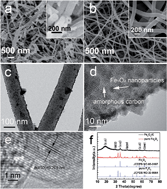Fe3O4/carbon composites obtained by electrospinning as an anode material with high rate capability for lithium ion batteries†
Abstract
Fe3O4 is a promising high-capacity (with a theoretical capacity of 922 mA h g−1) anode material for lithium ion batteries (LIBs). But it usually exhibits poor cycling stability because of its large volume change during the Li+ insertion/extraction process. In this paper, a facile strategy through the use of Fe3O4/carbon composites (Fe3O4/C composites) fabricated by simple electrospinning method was proposed to improve electrode performance. The Fe3O4/C electrode exhibits a high reversible capacity of 508.2 mA h g−1 at a current density of 100 mA g−1 after 100 cycles, about 89.6% of the capacity is maintained. Moreover, it shows good rate capability and delivers a reversible capacity of 520.0, 448.8, 250.0, 268.8, 160 mA h g−1 at the current densities of 200, 500, 1000, 2000, 5000 mA g−1, respectively. Additionally, it displays a good capacity recovery property, which can be attributed to the designed fiber architecture with active material implantation as well as the protection of the carbon skeleton. The interconnected particles of Fe3O4 in the carbon nanofibers (CNFs) ensure a good contact in the composites. Moreover, the one-dimensional CNFs act not only as a support with good stability, but also provide a shortened transport pathway for Li ions.


 Please wait while we load your content...
Please wait while we load your content...